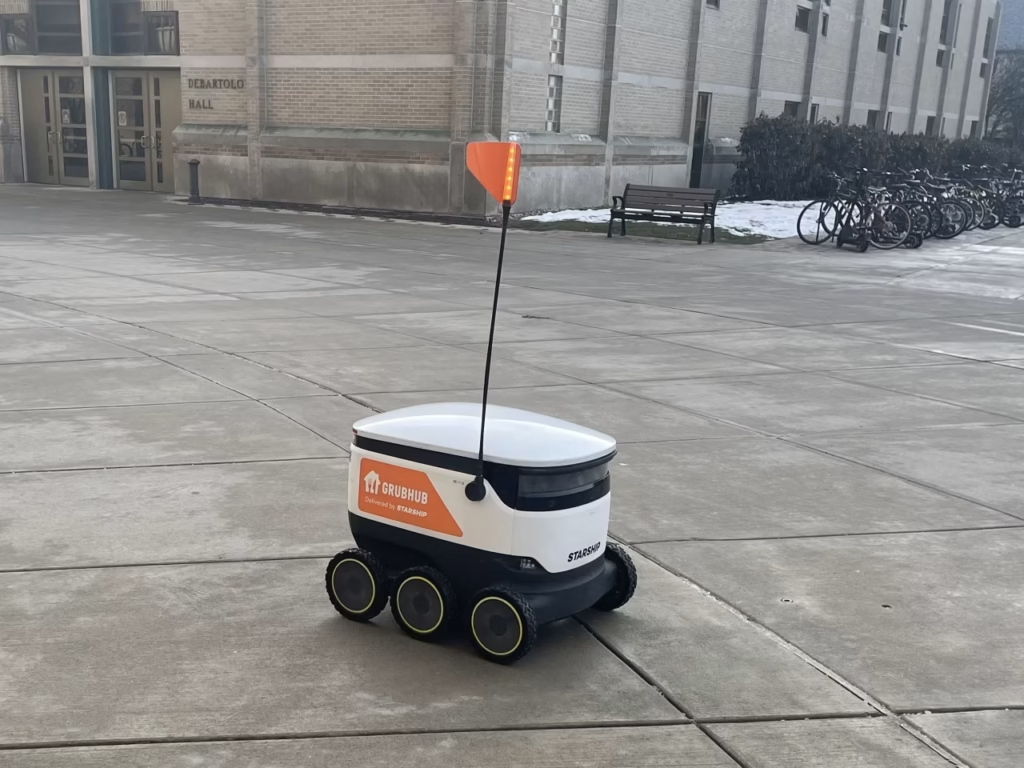food delivery robots have started popping up in cities around the world. They promise a future of contactless, fast, and eco-friendly food delivery. But the real world isn’t always friendly to these cute little machines.
From being flipped over by pranksters, tricked into dead ends, or getting stuck in snowbanks, these robots are learning the hard way that city streets are no joke. What was meant to be a tech solution for convenience is now facing harsh street reality.
Let’s dive into what’s really happening to these futuristic food couriers — and whether they can survive the chaos of urban life.
The Rise of Food Delivery Robots
Food delivery robots were designed to be helpful, efficient, and safe alternatives to human delivery workers. Small, boxy, and rolling on six wheels, these robots can navigate sidewalks using cameras, GPS, and artificial intelligence.
Companies like Starship Technologies, Kiwibot, and Serve Robotics have launched thousands of these bots across U.S. college campuses and urban neighborhoods. In theory, they’re perfect: they don’t get tired, they don’t need tips, and they cut down on vehicle emissions.
But despite their high-tech brains, these food delivery robots often struggle with the same thing we all do — life on the street.
Flipped and Abused — Pranks on the Rise
You might think most people would be amused by a food delivery robot politely navigating a sidewalk. And many are. But there’s a darker side to their fame.
In several cities, videos have surfaced showing these robots being flipped over by pedestrians, kicked, or blocked on purpose. In some cases, people sit on them or try to steal their contents. While some might think it’s harmless fun, it raises serious questions.
- These are machines with expensive tech inside
- Their services rely on reliability and safety
- Damaging them affects real customer deliveries
Companies are trying to fight back. Some robots now feature security cameras, alarms, and even voice alerts to warn people away. But that doesn’t always stop the troublemakers.
Tricked by the Terrain — Navigating City Hazards
Even when people aren’t trying to prank them, city life poses a whole new set of problems for food delivery robots.
Here’s what they struggle with:
- Snowbanks and ice: These little bots aren’t built for winter weather. In places like Pittsburgh or Minneapolis, robots have been found spinning their wheels hopelessly in the snow.
- Uneven sidewalks: Potholes, steep curbs, or broken pavement can trip them up, leaving them stuck until a human comes to help.
- Crossing streets: Even though some bots have systems to sense traffic, they can still get stranded in the middle of crosswalks, slowing down cars and putting themselves at risk.
- Construction zones: Robots rely on map data to plan routes. But in dynamic cities, roads close and sidewalks vanish overnight. That’s a tough challenge for even the smartest AI.
In many cities, these issues have caused delays, failed deliveries, and even traffic problems.
Can They Handle Human Environments?

Despite being loaded with sensors and programmed to detect obstacles, food delivery robots are still learning how to deal with the unpredictability of humans. Unlike a computer simulation, city streets have people on scooters, curious dogs, kids playing, and random accidents.
A few real-life situations food delivery robots have encountered:
- Getting trapped inside an elevator
- Waiting endlessly at doors because no one answered
- Trying to cross during a parade
- Being led in circles by pranksters yelling false directions
This all proves a simple truth: a city is a wild, complex environment that’s hard to tame — even for a robot.
How Are Companies Responding?
Despite the setbacks, robot companies are not giving up. They’re adapting — fast.
Here’s how they’re improving the bots:
- Better wheels for rough terrain and snow
- Smarter AI that can learn from new challenges
- More cameras and sensors to improve navigation and detect hazards
- Live monitoring where a human can take over remotely if the robot is in trouble
- Emergency help features, like calling for human assistance or rerouting when stuck
Some companies are even working with cities to create robot-friendly zones or clear sidewalk paths for bots. Others are testing bots with small arms or extendable wheels to climb curbs.
These developments show promise — but they also highlight how much effort it takes to make robots work in messy human spaces.
Are Food Delivery Robots Worth the Trouble?
Here’s the big question: Is it worth investing in food delivery robots if they keep getting stuck, flipped, or abused?
Supporters say yes. They argue that:
- The robots are improving rapidly
- They reduce labor costs and emissions
- They can serve late-night or low-staff zones
- Over time, they’ll become more accepted
Critics, however, warn that:
- They displace human workers
- They clutter sidewalks and risk safety
- They still rely heavily on human help
- They may not be suitable for all climates
In some cities like San Francisco and Toronto, there’s already pushback. Some lawmakers want to restrict where robots can go or limit their numbers on sidewalks.
Others embrace the innovation — especially college towns, where campuses are ideal for testing and students enjoy the novelty.
Real Stories — When Robots Go Wrong
To truly understand the chaos, here are a few real stories of food delivery robots in the wild.
The Snow Trap in Denver
A Starship robot delivering lunch got stuck in a deep pile of snow. Students tried to help, but its wheels kept spinning. The robot calmly said, “Obstacle detected,” while freezing in place for over an hour.
Blocked by a Parade in Los Angeles
A Serve robot carrying tacos got stuck behind a community parade. It had no idea how to navigate around the crowd and simply stood still for over 30 minutes until a remote operator intervened.
The Maze Prank in Texas
A group of teens surrounded a robot and guided it into a dead-end alley. The confused bot kept trying to back up and reroute. Eventually, a company employee had to pick it up and restart it.
These incidents show that even well-programmed bots are no match for unpredictable situations or mischievous humans.
What’s Next for Food Delivery Robots?
The future of food delivery robots depends on three key things:
- Tech Improvements
Companies must continue refining AI, obstacle detection, and mobility. - City Collaboration
Cities need to help with regulations, sidewalk access, and public education. - Public Behavior
People need to respect and understand these bots are not toys — they’re part of a growing tech shift.
If all three align, food delivery robots could become as normal as seeing a delivery van or bike rider. But if pranks, weather, and poor planning continue, the streets might remain too mean for these well-meaning machines.
Final Thoughts
Food delivery robots are a clever solution to a modern problem — but they’re facing very real challenges on our sidewalks. They can’t climb stairs. They slip on snow. They get tricked by humans and stuck behind obstacles. The streets, it seems, are not ready for them… or maybe they’re not ready for the streets.
But with better design, smarter AI, and more thoughtful integration into urban life, they might just survive the chaos. One thing’s for sure: the path to robotic delivery isn’t as smooth as it seemed.
Read Next – Paramount Trump Lawsuit Settlement: $16 Million Deal Explained





